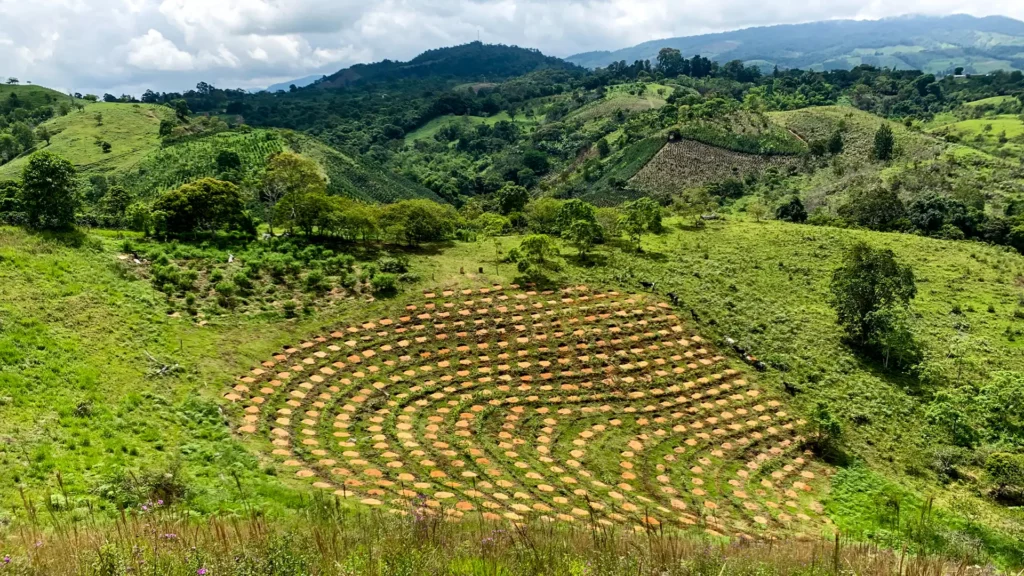Colombia
Finca el Suelo

About Finca el Suelo
Owned and run by Tim Wendelboe, Finca el Suelo is a 7 hectare farm located in El Vegon, in the municipality of El Pital in Huila, Colombia. It lies on an altitude of 1650 – 1700 masl. next to Finca Tamana.
This is the first time we have farmed coffee, so we consider this a learning project. We work only with nature, focusing on bringing our soil back to life by making our own compost as the main inoculant for increasing beneficial soil microbe populations.
We believe that healthy soils will give us healthy trees and better coffees.
Our goal is to figure out how to raise coffee quality and increase production with regenerative biological farming practices, and hopefully inspire other farmers to do the same.
But we have to succeed first.
Farm location: Huila, Colombia

Our Fourth Harvest
At the moment we have planted around 600 trees on the farm. Most of those coffee trees are Ethiopian landrace cultivars and a few Geisha trees. We also have a small Cultivar museum / garden where we keep a few trees of different cultivars to see how they perform and in order to keep a small seed bank of these rare coffee trees.
Most of the trees that are producing were planted in the field in early 2019 and 2020. From August 2021 we started picking small amounts of coffee from our Ethiopian Landrace trees along with a few of the cultivars in our museum / cultivar garden.
In the 2024 main harvest, between May and August, we were able to harvest slightly more coffee than last year with a total yield of 50+ kg of green coffee.
Like in 2023, we had a long period with no rain and very dry conditions in 2024. This affected the quality of our coffees as some trees were attacked by rust. But due to extensive separation and selection of each picking, we managed to produce a good amount of tasty coffee also this year.
After tasting and doing extensive quality control, we ended up with 28 kg of the best quality from our Ethiopian landrace cultivars and 14 kilos of coffee from our cultivar garden that we made a field blend of.
We will be roasting this coffee on our Loring S35 roaster on the 29th of April. Since we only have small amounts of the two lots of coffees, we only have one shot at roasting each lot. Fortunately we now have a lot of experience with roasting different cultivars and coffees from our neighbouring farm, Finca Tamana so we have a good idea of how we want to roast these coffees.
Finca El Suelo Timeline
2015
We take ownership of the parcel of land that would be come Finca El Suelo. We begin the process of applying compost tea, planting shade trees and of course, planting coffee.
2018
The farm is not progressing because the soil isn’t healthy enough. Most of the trees we planted in 2015 are dead. We start planning for planting new coffee trees in less quantities to focus our attention on smaller areas of the farm.
2020
A total of 600 coffee trees are now growing and they are growing quite well due to the new planting techniques that we learned while visiting in Kenya. Because there are less trees we are able to add loads of wood chips, compost, compost extract and compost tea.
2021
In late 2021 we were able to harvest the first cherries from our farm. The 110 trees we planted in 2019 are growing tall and are producing a good amount of coffee cherries. The volumes are still small but big enough to bring some home to roast and sell.
2025
We started working wth Biofilia, a Mexican company specialising in biological farming techniques. They will help us improve our farm and increase our production. We also hired a farm administrator, Yurani Roa (Elias Roa’s daughter,) in order to help us with the practical work on the farm. We are now hopeful that we have made a good strategy for the years to come and we have already started a lot of new work to improve the existing coffee trees on the farm as well as planning for new areas to be planted on the farm with Sudan Rumé cultivars.

Learn more about Finca el Suelo
Please note, you need to accept functional cookies to be able to play the video.
